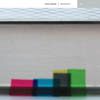Steve Roden, "Proximities", "Forms of Paper"
 Paring a recently released new work with a digital-only remastered reissue from the label, there is a decade of time elapsed between these two compositions, in which Roden’s evolution as an artist can be heard, particularly in his use of digital processing and composing.
Paring a recently released new work with a digital-only remastered reissue from the label, there is a decade of time elapsed between these two compositions, in which Roden’s evolution as an artist can be heard, particularly in his use of digital processing and composing.
Proximities is the result of a live synth performance recorded within a former army barracks, captured on a digital recorder, an iPhone, and an old microcassette recorder.The sparse sounds were then layered and placed alongside each other, with a simple tone progression expanded into a complex whole.
The piece opens with Spartan layers of sound: slowly rising and falling washes of synth tones mirroring the haze of the early morning, when the raw material for this work was recorded.There is a slow build, eventually paring the fragile synthetic tones with a grimier, dirty underbelly, likely sourced from lo-fi audio detritus.
The tones are slow and structured, and while they are somewhat repetitive, there is a constant flow: a river of sound that never stands still.As the piece comes to its conclusion, there is an even greater sense of chaos and fluidityWhile the basic tonal structure stays constant, everything around it disintegrates and eventually only the hollow environment in which recording took place can be heard.
Forms of Paper was released by Line in 2001, remastered by Bernard Guenter and reissued as a high quality download.While it was one of the heralding works of the "lowercase" genre (a genre of which the boundaries and parameters I never fully understood), there is far too much complexity for it to be pigeonholed into a label that would imply that nothing happens in the recording.
In fact, quite the opposite is true:although the piece takes a while to make itself known, Roden's processing of the sound of book pages becomes a world of subtle beeps and tones, with a greater focus on textures.While there is a more significant shifting between busy and sparse, it is a more repetitive work in comparison to Proximities.Not surprising since, in the accompanying essay, Roden points out that this was his first work utilizing Pro-tools rather than just analog tape, and that at the time he was quite fond of using copy and paste in composition.
While Roden may have begrudgingly entered the world of computer composition on Forms of Paper, his proficiency in its use is obvious within Proximities.The careful balance of tones and ambience are compelling and demand close attention, with a satisfying payoff.
samples:
 




